Accommodation · Adventure Travel · Cruises & Boat Travel · Ecuador · Hotels · Leisure Travel · Regions · South America · Speciality Travel
Galapagos cruises versus hotel-based island hopping
Sea legs. Of all the new sensations during my visit to the Galapagos Islands, that was perhaps the strangest. On about day five of my seven-day catamaran cruise aboard Treasures of Galapagos, I began to notice it. When we made it ashore to a visitor site, I was still swaying, still compensating for the gentle motion of the boat.
 Life at sea my naturalist guide had called it. He had been working both on land and on ship in the Galapagos for almost 20 years. He shared his wisdom about opting for a Galapagos cruise versus a hotel-based stay. You wont understand the scope of the archipelago unless you reach some of the farther islands by cruise ship, he observed. But you have to agree to life at sea.
That opened the question: is a Galapagos cruise for everyone? Or are there hotel-based island-hopping alternatives poised to compete? The answer, of course, depends on each travelers unique set of preferences. After nine days on the Galapagos Islands both by land and by sea, I think the ultimate experience is a combination of both.
Galapagos cruise ships
Pros
The big picture. As my guide pointed out, a cruise is the best way to get a big-picture panorama of the archipelago. The seven- or eight-day itineraries will take you to remote visitor sites on uninhabited islands that are only reachable by cruise, such as Fernandina in the far west.
Time-efficient. Cruises are best for time budgeting. Ships will be navigating at night, allowing you to fall asleep at one visitor site and wake up at another. Fewer daylight hours are spent in transit.
Convenient. As with cruising in general, you can sit back and let the ship do all the work. The itinerary is set. Meals are taken care of. Best of all, you only have to unpack and pack your suitcase once.
Cons
Life at sea. Although larger ships and premier catamarans have come a long way in stabilization, a boat is still a boat. It will rock. This is an important factor for anyone who is sensitive to motion sickness or sensations like sea legs. The first night on my cruise, the ship was navigating and I hardly slept. I eventually got used to it, but for light sleepers, a hotel-based stay might be a better idea.
No internet. Whether this belongs in the pros or cons column is another debate entirely. I found seven days of disconnection to be truly revitalizing. But for those who need to be reachable or who get uncomfortable if they arent, this could become a source of anxiety.
Confinement. Even on the most luxurious cruise options with wide cabins and plenty of deck space, cruise passengers are subject to cabin fever, especially restless kids faced with ample downtime on board between site visits.
Hotel-based island hopping
Pros
Flexibility of dates. Cruises have fixed departure dates that may not fit within your vacation window, especially if youre set on a certain size or grade of boat. Hotels, on the other hand, are more accommodating to very specific date ranges.
Flexibility of schedule. While I was aboard the cruise, a certain routine emerged. Breakfast, site visit, snorkel, lunch, rest, site visit, dinner, sleep. By the time I reached my hotel, I was quite happy to eat and explore on my own schedule, without answering to the ring of a bell.
Inland activities. Most cruise itineraries are limited to coastal visitor sites. This means you may miss the highlands of Santa Cruz, which is where the giant tortoises are found in the wild. Staying on land, youll also have more activity options, such as scuba, kayak, bicycle rental, hiking a volcano rim, shopping, or just relaxing and taking a leisurely walk. The absolute highlight of my stay at Galapagos was an introductory scuba dive, which wouldnt have been possible on a cruise ship alone.
More land time and local people. Unlike the fixed schedules of a cruise, a hotel-based stay gives you the option of spending more time on shore. Since youll be staying on the inhabited islands, youll also get a better idea of the human side of the Galapagos and what life is like for the people who live there.
Cons
Speed boats. Unless you fly from island to island (which is an increasingly popular option), you will probably be reaching new environs via speedboat, which means a faster and therefore bumpier ride than cruise ships.
More transit time. If youre based on land, youll spend more daylight hours in transit, either by plane or by speed boat. If youre changing hotels, then count on extra check-in, check-out, and bag packing.
Less ground covered. As my naturalist guide pointed out, you really cant reach the farthest-flung uninhabited visitor sites and their wildlife viewing opportunities by another means but cruise ship.
Favorite cruise ships
Small-size: M/C Cormorant, a first-class 16 passenger catamaran with a great range of four-day, five-day, eight-day, and even 15-day itineraries.
Life at sea my naturalist guide had called it. He had been working both on land and on ship in the Galapagos for almost 20 years. He shared his wisdom about opting for a Galapagos cruise versus a hotel-based stay. You wont understand the scope of the archipelago unless you reach some of the farther islands by cruise ship, he observed. But you have to agree to life at sea.
That opened the question: is a Galapagos cruise for everyone? Or are there hotel-based island-hopping alternatives poised to compete? The answer, of course, depends on each travelers unique set of preferences. After nine days on the Galapagos Islands both by land and by sea, I think the ultimate experience is a combination of both.
Galapagos cruise ships
Pros
The big picture. As my guide pointed out, a cruise is the best way to get a big-picture panorama of the archipelago. The seven- or eight-day itineraries will take you to remote visitor sites on uninhabited islands that are only reachable by cruise, such as Fernandina in the far west.
Time-efficient. Cruises are best for time budgeting. Ships will be navigating at night, allowing you to fall asleep at one visitor site and wake up at another. Fewer daylight hours are spent in transit.
Convenient. As with cruising in general, you can sit back and let the ship do all the work. The itinerary is set. Meals are taken care of. Best of all, you only have to unpack and pack your suitcase once.
Cons
Life at sea. Although larger ships and premier catamarans have come a long way in stabilization, a boat is still a boat. It will rock. This is an important factor for anyone who is sensitive to motion sickness or sensations like sea legs. The first night on my cruise, the ship was navigating and I hardly slept. I eventually got used to it, but for light sleepers, a hotel-based stay might be a better idea.
No internet. Whether this belongs in the pros or cons column is another debate entirely. I found seven days of disconnection to be truly revitalizing. But for those who need to be reachable or who get uncomfortable if they arent, this could become a source of anxiety.
Confinement. Even on the most luxurious cruise options with wide cabins and plenty of deck space, cruise passengers are subject to cabin fever, especially restless kids faced with ample downtime on board between site visits.
Hotel-based island hopping
Pros
Flexibility of dates. Cruises have fixed departure dates that may not fit within your vacation window, especially if youre set on a certain size or grade of boat. Hotels, on the other hand, are more accommodating to very specific date ranges.
Flexibility of schedule. While I was aboard the cruise, a certain routine emerged. Breakfast, site visit, snorkel, lunch, rest, site visit, dinner, sleep. By the time I reached my hotel, I was quite happy to eat and explore on my own schedule, without answering to the ring of a bell.
Inland activities. Most cruise itineraries are limited to coastal visitor sites. This means you may miss the highlands of Santa Cruz, which is where the giant tortoises are found in the wild. Staying on land, youll also have more activity options, such as scuba, kayak, bicycle rental, hiking a volcano rim, shopping, or just relaxing and taking a leisurely walk. The absolute highlight of my stay at Galapagos was an introductory scuba dive, which wouldnt have been possible on a cruise ship alone.
More land time and local people. Unlike the fixed schedules of a cruise, a hotel-based stay gives you the option of spending more time on shore. Since youll be staying on the inhabited islands, youll also get a better idea of the human side of the Galapagos and what life is like for the people who live there.
Cons
Speed boats. Unless you fly from island to island (which is an increasingly popular option), you will probably be reaching new environs via speedboat, which means a faster and therefore bumpier ride than cruise ships.
More transit time. If youre based on land, youll spend more daylight hours in transit, either by plane or by speed boat. If youre changing hotels, then count on extra check-in, check-out, and bag packing.
Less ground covered. As my naturalist guide pointed out, you really cant reach the farthest-flung uninhabited visitor sites and their wildlife viewing opportunities by another means but cruise ship.
Favorite cruise ships
Small-size: M/C Cormorant, a first-class 16 passenger catamaran with a great range of four-day, five-day, eight-day, and even 15-day itineraries.
 Mid-size: M/V Eclipse, a luxury expedition vessel with capacity for up to 48 passengers.
Mid-size: M/V Eclipse, a luxury expedition vessel with capacity for up to 48 passengers.
 Large-size: M/V Galapagos Legend, a first-class cruise ship with 100 passenger capacity. Bringing the whole family? The Legend has a kids corner for children.
Large-size: M/V Galapagos Legend, a first-class cruise ship with 100 passenger capacity. Bringing the whole family? The Legend has a kids corner for children.
 Favorite hotels
Galapagos Safari Camp – in the highlands of Santa Cruz, poised for exploring the Las Gemelas craters and giant tortoises in the wild. Creative yet comfortable lodging inside beautifully outfitted safari tents.
Favorite hotels
Galapagos Safari Camp – in the highlands of Santa Cruz, poised for exploring the Las Gemelas craters and giant tortoises in the wild. Creative yet comfortable lodging inside beautifully outfitted safari tents.
 Royal Palms Villa Escalesia on the bay of Puerto Ayora, with a private infinity pool. A dream residence for private groups of up to 12 people, this is where Angelina and Brad stayed with their kids during their recent visit!
Royal Palms Villa Escalesia on the bay of Puerto Ayora, with a private infinity pool. A dream residence for private groups of up to 12 people, this is where Angelina and Brad stayed with their kids during their recent visit!
 Finch Bay – Puerto Ayoras only beach-front hotel, with access to Las Grietas snorkeling haven. Other on-site activities like kayaking, bike rental, and hiking excursions available. A good base for trips with kids.
Finch Bay – Puerto Ayoras only beach-front hotel, with access to Las Grietas snorkeling haven. Other on-site activities like kayaking, bike rental, and hiking excursions available. A good base for trips with kids.
 The bottom line
Cruise-only visitors and hotel-only visitors really dont know what the other is missing. For the best of both worlds in the Galapagos, opt for a five- to seven-day cruise itinerary followed by at least two or three nights of land-based accommodations. That gives you at least one full land-based day for adventuring to the highlands of Santa Cruz, relaxing on a beach, or doing whatever it was that you wish your cruise had included.
Luis Felipa is the Founder and Owner of Southwind Adventures.
If you would like to be a guest blogger on A Luxury Travel Blog in order to raise your profile, please contact us.
The bottom line
Cruise-only visitors and hotel-only visitors really dont know what the other is missing. For the best of both worlds in the Galapagos, opt for a five- to seven-day cruise itinerary followed by at least two or three nights of land-based accommodations. That gives you at least one full land-based day for adventuring to the highlands of Santa Cruz, relaxing on a beach, or doing whatever it was that you wish your cruise had included.
Luis Felipa is the Founder and Owner of Southwind Adventures.
If you would like to be a guest blogger on A Luxury Travel Blog in order to raise your profile, please contact us.
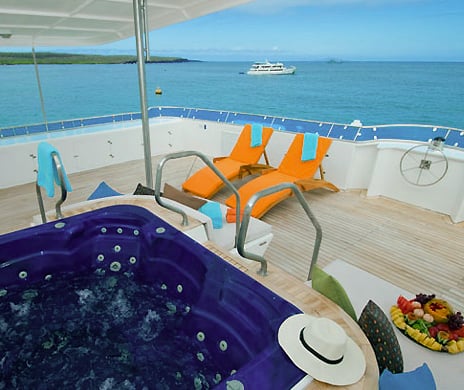 Life at sea my naturalist guide had called it. He had been working both on land and on ship in the Galapagos for almost 20 years. He shared his wisdom about opting for a Galapagos cruise versus a hotel-based stay. You wont understand the scope of the archipelago unless you reach some of the farther islands by cruise ship, he observed. But you have to agree to life at sea.
That opened the question: is a Galapagos cruise for everyone? Or are there hotel-based island-hopping alternatives poised to compete? The answer, of course, depends on each travelers unique set of preferences. After nine days on the Galapagos Islands both by land and by sea, I think the ultimate experience is a combination of both.
Galapagos cruise ships
Pros
The big picture. As my guide pointed out, a cruise is the best way to get a big-picture panorama of the archipelago. The seven- or eight-day itineraries will take you to remote visitor sites on uninhabited islands that are only reachable by cruise, such as Fernandina in the far west.
Time-efficient. Cruises are best for time budgeting. Ships will be navigating at night, allowing you to fall asleep at one visitor site and wake up at another. Fewer daylight hours are spent in transit.
Convenient. As with cruising in general, you can sit back and let the ship do all the work. The itinerary is set. Meals are taken care of. Best of all, you only have to unpack and pack your suitcase once.
Cons
Life at sea. Although larger ships and premier catamarans have come a long way in stabilization, a boat is still a boat. It will rock. This is an important factor for anyone who is sensitive to motion sickness or sensations like sea legs. The first night on my cruise, the ship was navigating and I hardly slept. I eventually got used to it, but for light sleepers, a hotel-based stay might be a better idea.
No internet. Whether this belongs in the pros or cons column is another debate entirely. I found seven days of disconnection to be truly revitalizing. But for those who need to be reachable or who get uncomfortable if they arent, this could become a source of anxiety.
Confinement. Even on the most luxurious cruise options with wide cabins and plenty of deck space, cruise passengers are subject to cabin fever, especially restless kids faced with ample downtime on board between site visits.
Hotel-based island hopping
Pros
Flexibility of dates. Cruises have fixed departure dates that may not fit within your vacation window, especially if youre set on a certain size or grade of boat. Hotels, on the other hand, are more accommodating to very specific date ranges.
Flexibility of schedule. While I was aboard the cruise, a certain routine emerged. Breakfast, site visit, snorkel, lunch, rest, site visit, dinner, sleep. By the time I reached my hotel, I was quite happy to eat and explore on my own schedule, without answering to the ring of a bell.
Inland activities. Most cruise itineraries are limited to coastal visitor sites. This means you may miss the highlands of Santa Cruz, which is where the giant tortoises are found in the wild. Staying on land, youll also have more activity options, such as scuba, kayak, bicycle rental, hiking a volcano rim, shopping, or just relaxing and taking a leisurely walk. The absolute highlight of my stay at Galapagos was an introductory scuba dive, which wouldnt have been possible on a cruise ship alone.
More land time and local people. Unlike the fixed schedules of a cruise, a hotel-based stay gives you the option of spending more time on shore. Since youll be staying on the inhabited islands, youll also get a better idea of the human side of the Galapagos and what life is like for the people who live there.
Cons
Speed boats. Unless you fly from island to island (which is an increasingly popular option), you will probably be reaching new environs via speedboat, which means a faster and therefore bumpier ride than cruise ships.
More transit time. If youre based on land, youll spend more daylight hours in transit, either by plane or by speed boat. If youre changing hotels, then count on extra check-in, check-out, and bag packing.
Less ground covered. As my naturalist guide pointed out, you really cant reach the farthest-flung uninhabited visitor sites and their wildlife viewing opportunities by another means but cruise ship.
Favorite cruise ships
Small-size: M/C Cormorant, a first-class 16 passenger catamaran with a great range of four-day, five-day, eight-day, and even 15-day itineraries.
Life at sea my naturalist guide had called it. He had been working both on land and on ship in the Galapagos for almost 20 years. He shared his wisdom about opting for a Galapagos cruise versus a hotel-based stay. You wont understand the scope of the archipelago unless you reach some of the farther islands by cruise ship, he observed. But you have to agree to life at sea.
That opened the question: is a Galapagos cruise for everyone? Or are there hotel-based island-hopping alternatives poised to compete? The answer, of course, depends on each travelers unique set of preferences. After nine days on the Galapagos Islands both by land and by sea, I think the ultimate experience is a combination of both.
Galapagos cruise ships
Pros
The big picture. As my guide pointed out, a cruise is the best way to get a big-picture panorama of the archipelago. The seven- or eight-day itineraries will take you to remote visitor sites on uninhabited islands that are only reachable by cruise, such as Fernandina in the far west.
Time-efficient. Cruises are best for time budgeting. Ships will be navigating at night, allowing you to fall asleep at one visitor site and wake up at another. Fewer daylight hours are spent in transit.
Convenient. As with cruising in general, you can sit back and let the ship do all the work. The itinerary is set. Meals are taken care of. Best of all, you only have to unpack and pack your suitcase once.
Cons
Life at sea. Although larger ships and premier catamarans have come a long way in stabilization, a boat is still a boat. It will rock. This is an important factor for anyone who is sensitive to motion sickness or sensations like sea legs. The first night on my cruise, the ship was navigating and I hardly slept. I eventually got used to it, but for light sleepers, a hotel-based stay might be a better idea.
No internet. Whether this belongs in the pros or cons column is another debate entirely. I found seven days of disconnection to be truly revitalizing. But for those who need to be reachable or who get uncomfortable if they arent, this could become a source of anxiety.
Confinement. Even on the most luxurious cruise options with wide cabins and plenty of deck space, cruise passengers are subject to cabin fever, especially restless kids faced with ample downtime on board between site visits.
Hotel-based island hopping
Pros
Flexibility of dates. Cruises have fixed departure dates that may not fit within your vacation window, especially if youre set on a certain size or grade of boat. Hotels, on the other hand, are more accommodating to very specific date ranges.
Flexibility of schedule. While I was aboard the cruise, a certain routine emerged. Breakfast, site visit, snorkel, lunch, rest, site visit, dinner, sleep. By the time I reached my hotel, I was quite happy to eat and explore on my own schedule, without answering to the ring of a bell.
Inland activities. Most cruise itineraries are limited to coastal visitor sites. This means you may miss the highlands of Santa Cruz, which is where the giant tortoises are found in the wild. Staying on land, youll also have more activity options, such as scuba, kayak, bicycle rental, hiking a volcano rim, shopping, or just relaxing and taking a leisurely walk. The absolute highlight of my stay at Galapagos was an introductory scuba dive, which wouldnt have been possible on a cruise ship alone.
More land time and local people. Unlike the fixed schedules of a cruise, a hotel-based stay gives you the option of spending more time on shore. Since youll be staying on the inhabited islands, youll also get a better idea of the human side of the Galapagos and what life is like for the people who live there.
Cons
Speed boats. Unless you fly from island to island (which is an increasingly popular option), you will probably be reaching new environs via speedboat, which means a faster and therefore bumpier ride than cruise ships.
More transit time. If youre based on land, youll spend more daylight hours in transit, either by plane or by speed boat. If youre changing hotels, then count on extra check-in, check-out, and bag packing.
Less ground covered. As my naturalist guide pointed out, you really cant reach the farthest-flung uninhabited visitor sites and their wildlife viewing opportunities by another means but cruise ship.
Favorite cruise ships
Small-size: M/C Cormorant, a first-class 16 passenger catamaran with a great range of four-day, five-day, eight-day, and even 15-day itineraries.
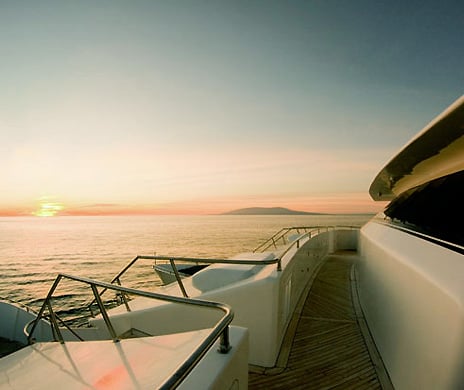 Mid-size: M/V Eclipse, a luxury expedition vessel with capacity for up to 48 passengers.
Mid-size: M/V Eclipse, a luxury expedition vessel with capacity for up to 48 passengers.
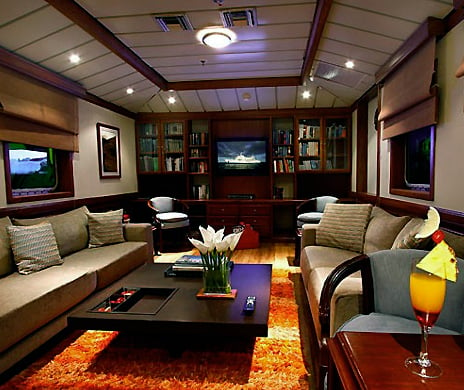 Large-size: M/V Galapagos Legend, a first-class cruise ship with 100 passenger capacity. Bringing the whole family? The Legend has a kids corner for children.
Large-size: M/V Galapagos Legend, a first-class cruise ship with 100 passenger capacity. Bringing the whole family? The Legend has a kids corner for children.
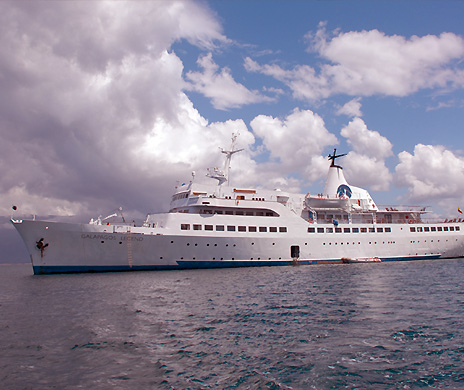 Favorite hotels
Galapagos Safari Camp – in the highlands of Santa Cruz, poised for exploring the Las Gemelas craters and giant tortoises in the wild. Creative yet comfortable lodging inside beautifully outfitted safari tents.
Favorite hotels
Galapagos Safari Camp – in the highlands of Santa Cruz, poised for exploring the Las Gemelas craters and giant tortoises in the wild. Creative yet comfortable lodging inside beautifully outfitted safari tents.
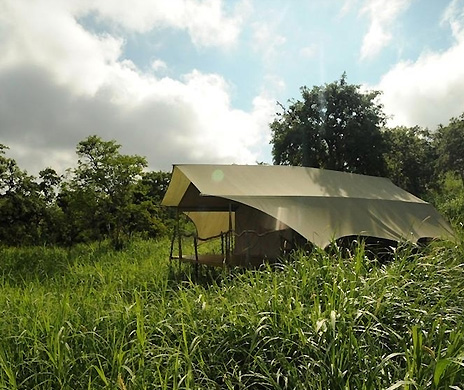 Royal Palms Villa Escalesia on the bay of Puerto Ayora, with a private infinity pool. A dream residence for private groups of up to 12 people, this is where Angelina and Brad stayed with their kids during their recent visit!
Royal Palms Villa Escalesia on the bay of Puerto Ayora, with a private infinity pool. A dream residence for private groups of up to 12 people, this is where Angelina and Brad stayed with their kids during their recent visit!
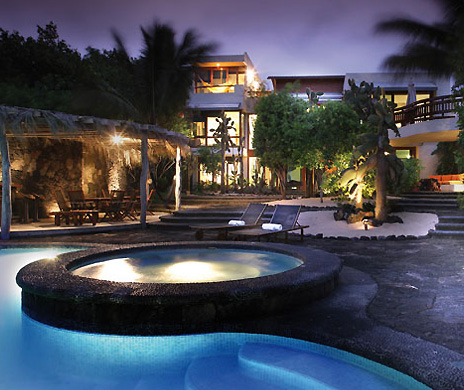 Finch Bay – Puerto Ayoras only beach-front hotel, with access to Las Grietas snorkeling haven. Other on-site activities like kayaking, bike rental, and hiking excursions available. A good base for trips with kids.
Finch Bay – Puerto Ayoras only beach-front hotel, with access to Las Grietas snorkeling haven. Other on-site activities like kayaking, bike rental, and hiking excursions available. A good base for trips with kids.
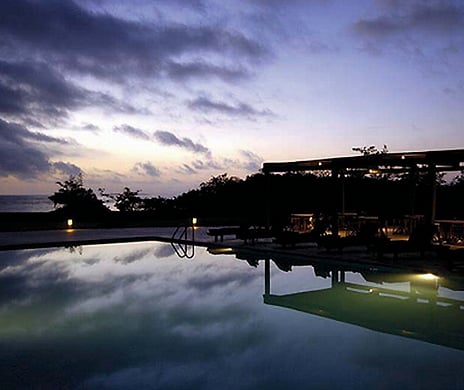 The bottom line
Cruise-only visitors and hotel-only visitors really dont know what the other is missing. For the best of both worlds in the Galapagos, opt for a five- to seven-day cruise itinerary followed by at least two or three nights of land-based accommodations. That gives you at least one full land-based day for adventuring to the highlands of Santa Cruz, relaxing on a beach, or doing whatever it was that you wish your cruise had included.
Luis Felipa is the Founder and Owner of Southwind Adventures.
If you would like to be a guest blogger on A Luxury Travel Blog in order to raise your profile, please contact us.
The bottom line
Cruise-only visitors and hotel-only visitors really dont know what the other is missing. For the best of both worlds in the Galapagos, opt for a five- to seven-day cruise itinerary followed by at least two or three nights of land-based accommodations. That gives you at least one full land-based day for adventuring to the highlands of Santa Cruz, relaxing on a beach, or doing whatever it was that you wish your cruise had included.
Luis Felipa is the Founder and Owner of Southwind Adventures.
If you would like to be a guest blogger on A Luxury Travel Blog in order to raise your profile, please contact us.Did you enjoy this article?
Receive similar content direct to your inbox.

